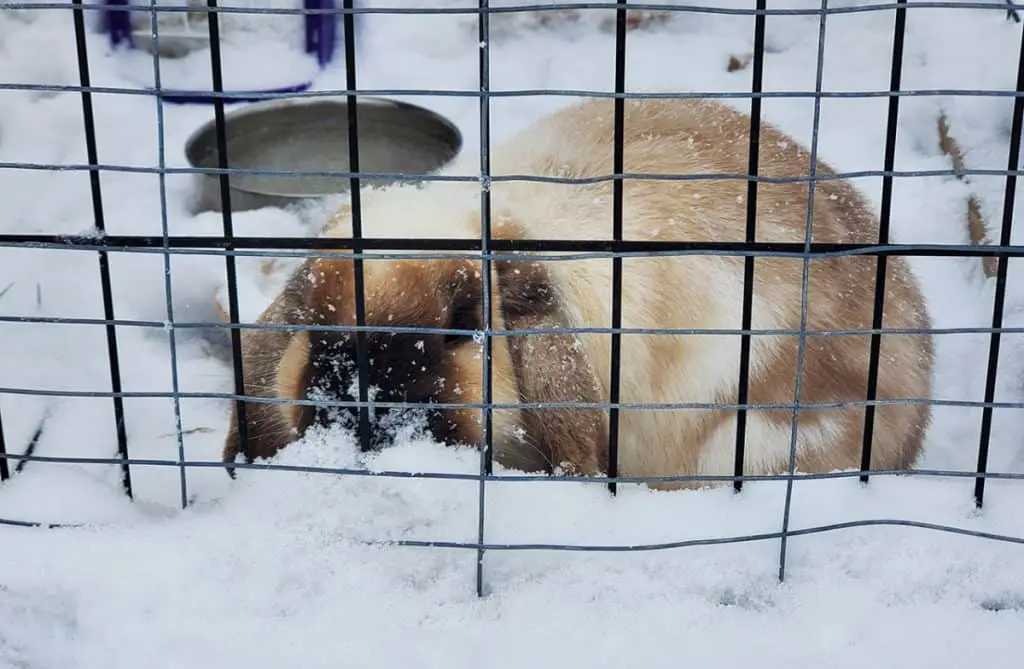Disclosure: We may earn money or products from the companies mentioned in this post.
My family has kept pet rabbits for years and the vast majority of those rabbits have spent most of their time outdoors. In this article, we’re going to talk about how an outdoor rabbit survives winter.
Let’s start with the basics.
Can Rabbits Live Outdoors In The Winter?
Pet rabbits can easily and happily live outdoors during the winter. Wild rabbits live outdoors all the time, and domestic pet rabbits can do the same as long as they are provided with reliable shelter from the winter weather.
Let’s start with why rabbit winter protection is so important.
Too Cold For Rabbits
In all of our years of having rabbits outside, we’ve never had one die from the cold. I can’t find any research saying how cold is too cold for a rabbit, but I can speak from my personal experience.
Rabbits thrive in cold weather and are even more playful in the winter months. However, as the temperature drops below 10 degrees Fahrenheit rabbits start to seek the safety of their bed box and the deep layer of hay found there. Rabbits easily survive -10 degrees Fahrenheit with protection.

Rabbits And Winter Hypothermia
Rabbits can and do die from hypothermia. Hypothermia occurs when the rabbit’s core body temperature drops below the normal range of 38.5 to 40 degrees Celsius (101.3 to 104 degrees Fahrenheit).
I have never seen a dry rabbit die of hypothermia. A wet rabbit or a rabbit who is sheltering in the bed box that is filled with wet hay or a wet blanket will be at risk of dying when the winter turns cold.
When the weather starts to turn cold, the first thing that we do is make sure their bedding is dry…but we’ll talk about that more in a bit.
The symptoms of hypothermia include your bunny’s ears feeling very cool to the touch and perhaps appearing more pale than normal. As hypothermia advances, your bunny might get more lethargic and might even seem confused. If you see signs of hypothermia, get your rabbit somewhere warm pronto.
If your rabbit seems to be in a stupor or has very shallow breathing, wrap your bunny in a warm blanket and get him to your veterinarian right away as death is quite possible.
The good news is that your bunny has a natural defense against this condition: rabbit fur.
While your bunny is naturally protected from cold weather by his heavy fur coat, domestic bunnies are not as hardy as their wild cousins.
The biggest advantage that wild rabbits have over your pet rabbit is that they usually live in underground burrows where they are better protected from cold winds.
One of the tactics that we’ll use to help your rabbit during the winter is to mimic those underground dwellings.

9 Ways To Keep An Outdoor Rabbit Warm
1. Weather Proof your Rabbit Hutch.
The most important thing that you can do for your outdoor bunny is making sure that their hutch is ready for winter.
Make sure that the roof is watertight. Cover at least three sides of the hutch to give your rabbit protection from the wind. Consider even temporarily covering half of the 4th side to create a safe space for your bunny within their hutch.\
Where we live, the winter wind normally comes from the north, so we strive to keep the north side of their outdoor cage covered.
If you have the means to afford such a high-end rabbit hutch, you should check out what I believe is the highest quality outdoor rabbit cage.
2. Move Your Rabbit Hutch
Moving your rabbit hutch to a more protected space might be the easiest solution to protecting your rabbit from the winter wind.
One of the first places people think of is the garage, but be careful putting the hutch in the garage, as the fumes from the cars are not good for your little friends.
However, moving your outdoor rabbit to a place where the front of their hutch is protected from the predominant winter winds in your area (in our area winter winds flow mostly from the NorthWest) can make a big difference.
You should also look for places where the winter sun, which tends to be lower in the southern sky can shine down on your bunny for mid-day warmth. Besides, it’s super cute to see your bunny spread out soaking in the sun on cold winter days.
3. Proper Sized Bed Box
A bed box or nesting box is an essential piece of equipment for an outdoor rabbit. Your rabbit will not only use their bed box for protection from winter winds but for shade from the summer sun.
With a properly sized box, your rabbit will be able to get away from those winter winds in the safety of their dark box (almost like an underground burrow…but we can make it better.)
An outdoor rabbit bed box should have an entrance that is large enough for your rabbit to easily step through, but no larger. The inside should be big enough that your rabbit can easily turn around, but no bigger. Finally, all sides of the box, including the bottom, should be solid wood.
You can easily build your own nesting box, but if you want to get one ready-made, we’ve included a variety of them available on Amazon in the links below. These are affiliate links, and when you make a purchase through these links we make a small commission at no additional cost to you.
4. Add A Flap To The Bed Box
An underground burrow will have twists and turns to keep the winter wind from driving snow into a wild rabbit’s nest.
If you add either a double door (two doors offset so the wind doesn’t blow straight into the nesting box) or a flap made from an old blanket to help seal the door, you will mimic this situation.
You can also face the nesting box door towards a solid wall of her hutch, leaving just enough room for your bunny to get to the door.
5. Add Extra Straw Bedding
Straw is a naturally insulated bedding for your rabbit. When it’s really cold, give them a warmer bed made up of a deep layer of dry straw or hay.
When it’s going to get really cold (near zero degrees Fahrenheit) you should fill the bed box of your outdoor rabbit’s two-thirds full with clean, dry straw or hay that is placed in the box loosely and not packed in tight. Your rabbit will burrow into that hay to stay warm.
6. Change the Straw Bedding Regularly
As I said above, I’ve never seen a dry rabbit die of cold. However, wet bedding will lead to a wet rabbit.
The straw in your nesting boxes will get moist year-round, but it gets wetter in winter through condensation and your bunny choosing not to go outside to use the bathroom.
That wet straw gets really cold at night, so change it regularly. That means that you are going to completely remove the old hay and all the manure and replace it with fresh dry hay.
During the winter months, we prefer to use the same hay we feed our rabbits for bedding to make sure that they have a high-quality diet even when hunkering down on the coldest nights.
Check your rabbit’s bedding at least every other day, and replace it with fresh straw as needed.

7. Add A Woven Bed
If you want to spoil your bunny, ours love these woven beds (here is an affiliate link to the ones we get on Amazon).
We don’t put these beds in our bunnies’ bed boxes which we only put dry hay inside of. Instead, we put these woven beds in the protected portion of the outdoor hutch.
Our bunnies seem to enjoy a warm comfortable place to sit at night (After all, they are mostly nocturnal.)
8 Add A Water Heater
If your hutch has access to electricity, consider purchasing a water heater (here is a link to an example on Amazon). The warm water will not only assure that your bunny always has access to water, but that water will be warm to drink even on the coldest night.
While your rabbit is going to be fine when the temperature is below freezing, her water will be frozen solid and she needs water to live. That means that you are going to be removing the frozen water and replacing it with warm water at least a few times a day.
If you don’t have a water heater, you must give your rabbit a warm drink of water at least two times a day during the winter. Preferably you’ll be taking her warm water four times a day when the weather is below freezing.
9. Heated Pad
If you want to take the spoiling of your furry friend to the next level, go with a heated pad specifically designed for rabbits (like this one on Amazon).
We don’t have any of these, and if we did get one I don’t think we’d put it in with the straw. Instead, we’d use it outside like we use the woven bed in #7.
Worrying About Your Outdoor Bunny In The Winter
Please, don’t worry too much about your outdoor bunny during the winter.
Rabbits are built for living outdoors during the winter, and while years of domestication have weakened some of their natural winter hardiness, it still resides in their tiny bodies. They just need a little help from you to thrive through the colder days and now you know what you can do to help them.
Have fun and say “Hi’ to your bunny from the team here at RabbitPros.com!
P.S. If you have tips that would help other bunny lovers, please leave them in the comments below. We are all rabbit lovers!
